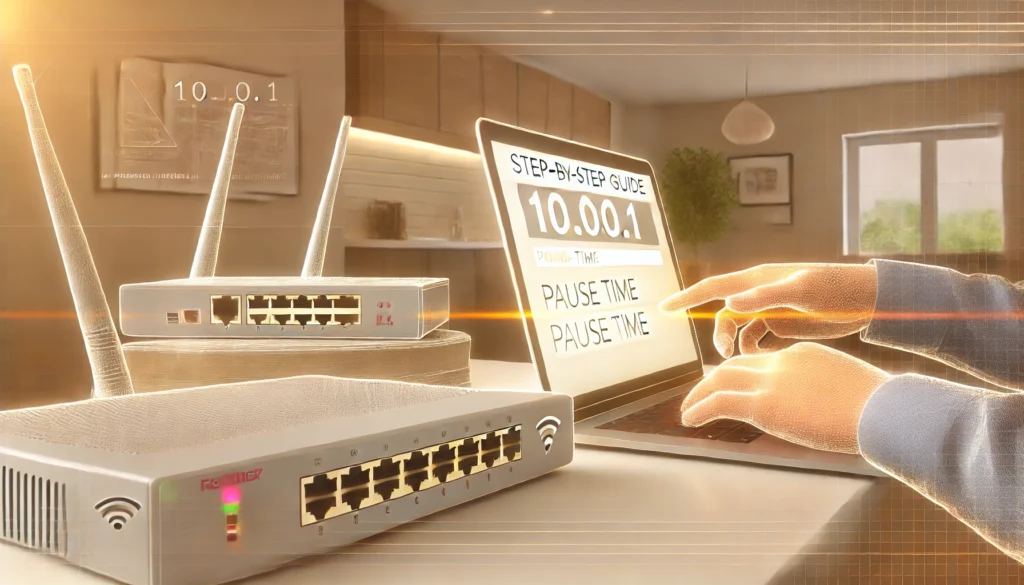Introduction
If you’ve ever dealt with network configurations, you might have come across the IP address 10.0.0.1. It’s a common default gateway address used by many routers and modems. But what exactly is the 10.0.0..1 Pause Time, and why does it matter to you?
In simple terms, the 10.0.0.1 pause time refers to the time it takes for a connection or process to halt or delay when using this specific IP address. This pause can impact your internet speed and overall network performance, especially when accessing certain settings or managing your devices. Whether you’re a tech enthusiast or just someone trying to improve your home network, understanding the 10.0.0.1 pause time can help you troubleshoot issues and optimize your setup for a smoother online experience.
In this article, we’ll explore what causes the pause time, how it affects your network, and practical steps you can take to reduce it. By the end, you’ll have a better grasp of how to manage your network effectively using 10.0.0.1 and ensure your internet connection is running at its best.
What is 10.0.0.1 Pause Time?

The 10.0.0.1 pause time refers to the delay or latency experienced when accessing or interacting with the IP address 10.0.0.1. This IP address is commonly used as a default gateway for routers and modems, allowing users to access their device’s administrative settings through a web browser.
Understanding the Pause Time
When you enter 10.0.0.1 into your browser, you’re trying to communicate with your router to manage settings like Wi-Fi passwords, security options, or network preferences. The pause time is the delay between sending this request and receiving a response from the router. This pause can be influenced by several factors:
- Network Traffic: High levels of network activity can slow down the response time, causing a noticeable delay.
- Router Performance: Older or overloaded routers might take longer to process requests, leading to increased pause times.
- Device Configuration: Incorrect or outdated settings can contribute to delays when accessing the router’s admin panel.
- Interference: Physical obstacles or electronic interference can affect the signal strength and lead to longer pause times.
Why Does It Matter?
Understanding and minimizing the 10.0.0.1 pause time is crucial for a few reasons:
- Improved Performance: Reducing the pause time can lead to a more responsive and faster network, enhancing your overall internet experience.
- Efficient Troubleshooting: If you’re experiencing connectivity issues, knowing about pause time can help you pinpoint and solve problems more efficiently.
- Better Device Management: Accessing your router’s settings without significant delays makes it easier to update configurations, improve security, and optimize your network.
You May Also Like It
Instagram Par Follower Kaise Badhaye With Can Follow Website – Veganov Trichy
1000+ Free Instagram Story Views In 2024– Veganov Trichy
How To Increase Followers On Instagram With TakipciGir New Update 2024
Why is 10.0.0.1 Pause Time Important?
Understanding the 10.0.0.1 pause time is crucial for anyone looking to optimize their home or office network. It plays a significant role in ensuring a seamless internet experience. Here are some key reasons why this pause time matters:
Enhances Network Performance
- Reduces Lag: A shorter pause time ensures that your network responds quickly to requests, minimizing lag and improving the overall browsing experience.
- Boosts Speed: By optimizing the pause time, you can achieve faster upload and download speeds, making activities like streaming and online gaming more enjoyable.
- Improves Connectivity: Reduced delays help maintain a stable connection, preventing frequent disconnects and ensuring smooth online sessions.
Facilitates Efficient Troubleshooting
- Identifies Issues: Understanding pause time helps pinpoint potential network issues, making it easier to diagnose and resolve connectivity problems.
- Speeds Up Solutions: With knowledge of pause time, you can quickly implement fixes, reducing downtime and maintaining a reliable connection.
- Prevents Overloads: By monitoring pause time, you can prevent your router from becoming overloaded, which can lead to network crashes or sluggish performance.
Supports Better Device Management
- Simplifies Configuration: A shorter pause time allows for quicker access to the router’s admin panel, making it easier to update settings and configurations.
- Enhances Security: Prompt access to network settings enables timely updates to security protocols, safeguarding your network against potential threats.
- Optimizes Network Setup: With reduced delay, you can efficiently manage connected devices, ensuring they operate smoothly and don’t interfere with each other.
Improves User Experience
- Smooth Streaming and Gaming: A minimal pause time means less buffering and latency, enhancing entertainment experiences.
- Faster Browsing: Quick response times make browsing the web more efficient, allowing you to access websites and information without frustrating delays.
- Better Video Calls: Reduced latency ensures clearer and more stable video calls, preventing interruptions during important conversations.
Enhances Work Productivity
- Reliable Remote Work: For those working from home, a stable and responsive network is essential for accessing online tools and collaborating with team members.
- Efficient Data Transfer: Fast and reliable connections enable seamless data transfer, improving productivity and workflow.
- Supports Multiple Users: An optimized pause time allows multiple users to connect without affecting each other’s experience, making it ideal for households or offices with several devices.
Step-by-Step Guide on 10.0.0.1 Pause Time

Step 1: Understanding 10.0.0.1 Pause Time
Before diving into optimization, it’s essential to grasp what 10.0.0.1 pause time means:
- Definition: The pause time refers to the delay experienced when accessing the router’s admin panel or making network requests using the IP address 10.0.0.1.
- Purpose: Understanding this pause time helps in diagnosing network issues and improving connection stability.
Step 2: Access Your Router’s Admin Panel
To begin optimizing your network, you’ll need to access the router’s admin panel:
- Connect to Your Network: Ensure your device is connected to the network you want to manage.
- Open a Web Browser: Launch your preferred web browser (e.g., Chrome, Firefox, Safari).
- Enter the IP Address: Type http://10.0.0.1 into the address bar and press Enter.
- Log In: Use your router’s default username and password to log in. If you’ve changed these credentials, use the updated login information. If you’ve forgotten your credentials, you may need to reset your router.
Step 3: Identify the Causes of Pause Time
Once logged in, identify potential causes for increased pause time:
- Network Traffic: Check for devices consuming excessive bandwidth. Disconnect or limit usage if necessary.
- Router Performance: Ensure your router firmware is up to date for optimal performance.
- Interference: Look for sources of signal interference, such as microwaves, cordless phones, or other wireless devices.
- Configuration Issues: Review the router settings for incorrect configurations that could lead to delays.
Step 4: Optimize Router Settings
Now that you’ve identified potential causes, follow these steps to optimize your router:
Update Firmware
- Check for Updates: Look for the firmware update option in the router’s admin panel.
- Install Updates: Follow the instructions to download and install the latest firmware version.
Adjust Bandwidth Settings
- Enable Quality of Service (QoS): Prioritize traffic for essential applications like streaming and gaming.
- Limit Bandwidth-Hogging Devices: Set bandwidth limits for devices that consume too much data.
Change Wireless Channel
- Access Wireless Settings: Locate the wireless settings section in your router’s admin panel.
- Change Channel: Select a less congested channel to reduce interference and improve signal strength.
Step 5: Reduce Physical Interference
To minimize physical interference affecting your network, follow these steps:
- Reposition the Router: Place your router in a central location, away from walls and obstructions.
- Elevate the Router: Position the router on a shelf or elevated surface for better signal distribution.
- Avoid Obstacles: Keep electronic devices and metal objects away from the router to prevent signal disruption.
Step 6: Test Your Network
After making the necessary adjustments, test your network to evaluate improvements:
- Check Connection Speed: Use online tools like Speedtest.net to measure your internet speed before and after optimization.
- Evaluate Pause Time: Access the router’s admin panel again to assess any reduction in pause time.
- Monitor Performance: Observe your network’s performance over time to ensure consistent improvements.
Step 7: Maintain Regular Network Checks
Consistent monitoring and maintenance can keep your network running smoothly:
- Regularly Update Firmware: Keep your router’s firmware up to date to benefit from the latest features and security patches.
- Monitor Network Usage: Use your router’s admin panel to track connected devices and bandwidth usage.
- Perform Routine Checks: Periodically review and optimize your router settings to prevent future issues.
Advantages
Understanding and optimizing the 10.0.0.1 pause time can provide several benefits, making your network more efficient and reliable.
Improved Network Performance
- Faster Response Times: Reducing pause time leads to quicker responses from your router, enhancing your internet browsing and online activities.
- Enhanced Speed: Optimizing pause time can boost download and upload speeds, providing a smoother experience for streaming, gaming, and more.
Efficient Troubleshooting
- Quick Problem Identification: Understanding pause time helps pinpoint network issues, allowing for faster and more effective troubleshooting.
- Reduced Downtime: By addressing pause time delays, you can minimize network downtime and maintain a stable connection.
Better Device Management
- Easier Configuration: Shorter pause times allow for swift access to router settings, simplifying the management and configuration of connected devices.
- Enhanced Security: Prompt access to network settings ensures timely updates to security features, protecting your network from potential threats.
Optimized User Experience
- Seamless Streaming and Gaming: Reduced pause time minimizes buffering and lag, improving entertainment experiences.
- Smoother Video Calls: Lower latency ensures clearer and more stable video calls, enhancing communication quality.
- Improved Productivity: For remote workers, a reliable network with minimal pause time boosts productivity by ensuring uninterrupted access to online tools.
Supports Multiple Users
- Balanced Bandwidth Usage: Managing pause time allows for fair bandwidth distribution among multiple users, preventing any single device from monopolizing resources.
- Stable Connections: Optimized pause times ensure all connected devices maintain stable connections, supporting households or offices with multiple users.
Disadvantages
While there are numerous advantages to managing the 10.0.0.1 pause time, there are also some potential drawbacks to consider:
Complex Configuration
- Technical Knowledge Required: Optimizing pause time may require a certain level of technical expertise, which can be challenging for non-tech-savvy users.
- Risk of Misconfiguration: Incorrect adjustments to router settings can lead to network issues, potentially worsening performance.
Time-Consuming Process
- Initial Setup: Identifying and optimizing pause time can be time-consuming, especially for those unfamiliar with network settings.
- Regular Maintenance: Maintaining optimal performance requires periodic checks and updates, which can be a burden for some users.
Hardware Limitations
- Older Routers: Older or low-quality routers may have inherent limitations that make it difficult to significantly reduce pause time.
- Incompatibility Issues: Some devices or software may not support the latest optimization features, leading to limited improvements.
External Factors
- Environmental Interference: Factors like physical obstructions and electronic interference can still affect network performance despite optimization efforts.
- ISP Limitations: Internet Service Providers (ISPs) may impose restrictions or have infrastructure issues that impact pause time and network speed.
Potential Security Risks
- Exposure to Vulnerabilities: Inexperienced users might inadvertently expose their network to vulnerabilities while attempting to optimize settings.
- Data Privacy Concerns: Incorrect configurations can lead to data privacy issues, allowing unauthorized access to sensitive information.
What is 10.0.0.1?
10.0.0.1 is an IP address used by many routers as a default gateway to access their settings. When you type 10.0.0.1 into your web browser, you can log in to your router’s admin panel to manage network settings, configure security, and troubleshoot issues.
What does “pause time” mean?
Pause time refers to the delay or lag experienced when trying to access your router’s settings or while performing tasks on the network. This can affect how quickly your router responds to commands, impacting things like browsing speed and network management.
Why does pause time matter?
Pause time is important because it affects how smoothly your network operates. Shorter pause times mean quicker responses from your router, which can lead to faster internet speeds, better streaming experiences, and more efficient network management.
How can I reduce pause time?
To reduce pause time, you can:
Update Router Firmware: Make sure your router’s software is up to date.
Manage Network Traffic: Limit bandwidth-heavy activities and prioritize important applications.
Reduce Interference: Position your router away from physical obstructions and electronic devices that might interfere with the signal.
Optimize Settings: Use features like Quality of Service (QoS) to prioritize network traffic.
Is 10.0.0.1 the same as 192.168.0.1?
No, they are different IP addresses. Both 10.0.0.1 and 192.168.0.1 are commonly used as default gateways for routers, but they belong to different private IP address ranges. The choice of which one to use depends on the manufacturer and model of the router.
Conclusion
Understanding and managing 10.0.0.1 pause time is key to optimizing your network for a smoother, faster internet experience. By learning what pause time is and how it affects your connection, you can take simple steps to reduce delays and improve performance. Whether you’re streaming videos, playing online games, or working from home, minimizing pause time ensures your network runs efficiently and reliably.
Taking a proactive approach to manage your network can lead to better speed, stability, and security. With just a few adjustments to your router settings, you can enjoy a more seamless online experience. Remember, a well-managed network benefits everyone in your home or office, so it’s worth taking the time to understand and optimize pause time.
Bonus Points on 10.0.0.1 Pause Time
Regularly Monitor Network Performance
- Use Network Monitoring Tools: Tools like Wireshark, Fing, or GlassWire can help you keep track of network performance and identify any unusual activity or congestion.
- Set Alerts: Configure alerts to notify you when your network experiences unusual traffic spikes or slowdowns, allowing you to address issues promptly.
Leverage Advanced Router Features
- Dual-Band Routers: Utilize both 2.4 GHz and 5 GHz bands to manage network traffic better and reduce interference.
- Guest Networks: Create a guest network for visitors to keep your main network secure and manage bandwidth effectively.
- VPN Integration: Consider using a VPN (Virtual Private Network) on your router for enhanced security and privacy, although be aware this may slightly impact pause time.
Optimize Connected Devices
- Limit Background Apps: On your devices, close or limit applications running in the background that consume bandwidth.
- Prioritize Important Devices: Use your router’s QoS settings to prioritize bandwidth for essential devices, ensuring they get the fastest speeds.
Consider Upgrading Hardware
- Invest in a Modern Router: If your router is outdated, consider upgrading to a newer model that supports the latest Wi-Fi standards, like Wi-Fi 6, for better performance.
- Use Range Extenders: If your network covers a large area, consider using Wi-Fi extenders or mesh networks to ensure strong signals throughout your home or office.
Secure Your Network
- Use Strong Passwords: Ensure your Wi-Fi network is protected with a strong password to prevent unauthorized access, which can affect network performance.
- Enable WPA3 Encryption: If supported, use WPA3 for better security, as older protocols like WEP or WPA are more vulnerable to attacks.
Stay Informed About Firmware Updates
- Check Manufacturer’s Website: Regularly visit your router manufacturer’s website for updates and announcements about new firmware releases.
- Enable Automatic Updates: If available, enable automatic updates to ensure your router’s firmware is always current, improving performance and security.
Educate Others in Your Household or Office
- Share Knowledge: Educate others about the importance of network management and how their activities can impact pause time and overall performance.
- Create a Network Usage Policy: Establish guidelines for bandwidth usage during peak times to ensure everyone gets a fair share of the connection.
Explore Custom Firmware Options
- Consider Open-Source Firmware: For tech-savvy users, custom firmware like DD-WRT or Tomato can unlock additional features and customization options to enhance your router’s capabilities.
- Proceed with Caution: Installing custom firmware requires careful attention, as it can void warranties or brick your device if done incorrectly.
You May Also Like It
Trendzguruji.me – Computer, Cyber, Awareness, SEO, Health & Beauty Guide
TrendzGuruji.me Cyber Insights Hub
“What’s Up with Emerald Gems? Let’s Talk”
